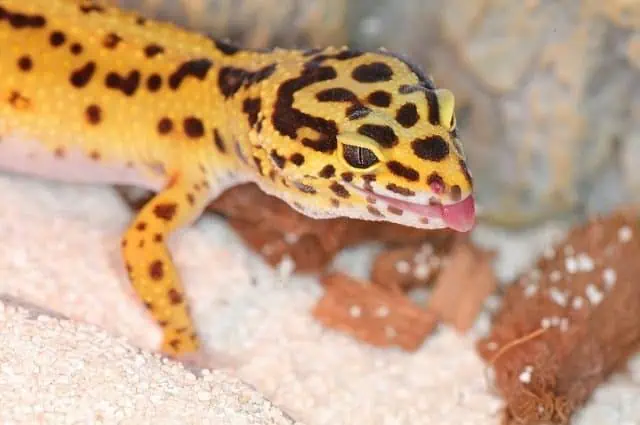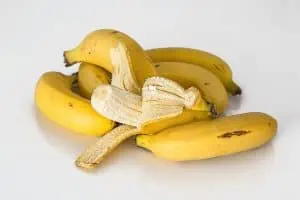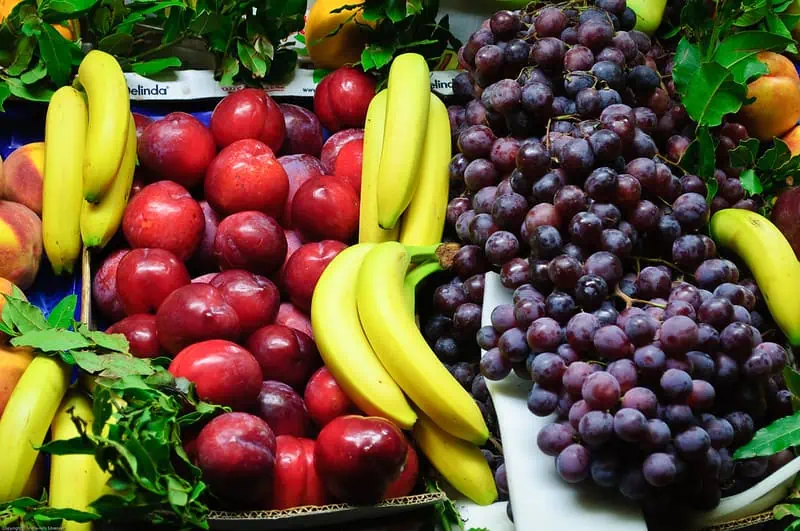Leopard geckos are easily the easiest geckos to maintain in the world. This is why they’re always recommended to children and first-time lizard keepers. They’re also very docile, which means they can get used to being handled without getting scared of you.

And if you plan on getting your own Leopard gecko, you should be very careful about their diet. It’s easy to follow once you learn what they can and can’t eat. These beautiful creatures are often called Leos and you will grow to love their quirky behavior very quickly.
In this article, we’ll talk about what these lizards can eat, how much, when, and what types of foods to avoid.
What can a Leopard Gecko eat? Diet Tips
As insectivores, Leos need a balanced diet of insects. And since they will eat anything you place in front of them that moves, it’s up to you to get informed on what they should eat to get the nutrients they need. If the gecko is not fed properly, it will start showing more and more signs of sickness and it will even get more aggressive.
How To Feed a Leopard Gecko
When the feeding time comes, you should slowly get the gecko out of its enclosure and place it in an empty cage or container. Make sure it has ventilation and that the gecko can’t get out of it when you’re looking away. Leos might be very docile but they’re also very fast. One second it’s there and the next it’s roaming the house.
You can make a temporary enclosure out of anything, including cardboard. But if having an extra container is not an option, you can place the insects inside the gecko’s own enclosure. It’s just very important to not leave any dead insects behind as they can build up bacteria over time and get the gecko sick.
Where To Get Insects To Feed to Leos
There are special people or companies that have experience in breeding feeder insects and you can get everything you need from them. They can also help you with the feeding schedule and answer all of your questions. But make sure it’s a reputable supplier to make sure you’re getting perfectly healthy insects.
You can also get the insects you need online as there are lots of commercial companies that breed insects specifically for lizards. And you don’t have to worry about getting them dead or anything as insects can easily travel all over the world if they’re properly packed. This is how tarantula pets make it from one side of the globe to the other.
And if you find buying the insects way too expensive, especially for more than one gecko, you always have the option of breeding your own feeder insects. The first-time setup might be a little difficult and pricey, but it gets a lot easier and affordable with time. Most keepers don’t buy insects for their geckos for years as breeding them themselves saves a lot of money.
You just have to do a lot of research and make sure you have the time and conditions to take care of the insects as well, especially since Leos need various types of insects. It’s important to treat the insects very well so they can remain healthy and help your Leo grow healthy as well.
Some insects are harder to breed at home and it’s best to have them shipped home, while others take the bare minimum to thrive. This includes cockroaches. All you need is the empty cardboard from eggs as they only need half an egg’s space per cockroach to thrive. Otherwise, they will start attacking each other and even eat one another. This is because they’re very territorial.
Insects That Are Bad For Leopard Geckos
Whatever you do, make sure your gecko stays very far away from lighting bugs, fireflies, and other types of bugs that glow in the dark. They contain a special chemical that allows them to glow. And while they’re pretty, this chemical is extremely toxic to geckos.
They’re so bad that even a single insect can contain a leather amount of toxins to kill a gecko. There’s also no treatment known so far as no gecko lives long enough to get to the vet.
Other types of insects you need to keep your gecko away from are the ones you caught around your home. This is because they contain parasites and chemicals that can also be very harmful to geckos. More than that, they will most likely have some type of pesticide on them that is also toxic for geckos.
Types of Insects to Feed Your Leopard Gecko
Now that we talked about what insects you should avoid, let’s start talking about the most popular insects used as feeders among reptile keepers. Just remember to always mix and match so they can have variety in their meals. There are several others that can work, in addition to the popular ones we mention below (such as snails and slugs as treats, etc).
Crickets: Regardless of where you go in the world, crickets are a big part of any insectivore gecko’s diet. They’re distantly related to grasshoppers and can be found all around the globe, at altitudes of up to 55-degrees high. This means you can easily get them no matter where you are.
If you don’t have a supplier next to you, buying crickets can be a bit costly if you have various geckos. This is why you can opt for breeding them yourself. You can choose between herbivorous or predatory crickets and raise them at home until they’re ready to be fed to your Leos.
Herbivore crickets eat flowers, leaves, and fruits, while predatory crickets eat larvae, pupae, invertebrate eggs, molting insects, scale insects, and aphids. You should ask the buyer about the food they need and if they have a species that thrives on commercial, dry dog food, as many crickets do.
Be very careful when you’re feeding them as they can easily jump out of their tank if you’re not careful. More than that, they have some quite powerful jaws and are known to bite humans if they feel threatened while you’re handling them.
Mealworms: These are the larva form of mealworm beetles and they also make a big part of a gecko’s diet. They are very high in protein content and not high in fats, making them perfect for creatures with low metabolisms, such as geckos. You can also breed them yourself or buy them, but this time it’s more affordable and hassle-free to just buy them.
Commercial growers are known to use a juvenile hormone in the diet of mealworms, which helps them remain in the larvae stage and grow bigger than normal. When you’re buying them, you will get them in containers that also contain bran or oatmeal that is used as their food for the ride.
Locusts: While they tend to be a bit pricier than crickets, locusts are still an excellent food option for Leopard geckos. They’re very rich in nutrients and they have their fair share of fatty acids as well. Locusts can even be used as regular food if you can afford it.
These insects have fatty, palmitoleic, oleic, and linolenic acids, along with various amounts of sodium, potassium, calcium, phosphorous, iron, magnesium, and zinc. This is why they’re also considered a delicacy in some countries as human food. But your Leo will probably appreciate the Locusts more than you.
You should also keep in mind that Locusts and grasshoppers are not different insects. Locusts are just simple grasshoppers that have reached the swarming stage of their life. This is why they’re very common and you won’t have a problem purchasing them. On the other hand, breeding them might be a bit more difficult as they’re known escape artists but not pretentious on food.
Waxworms: The Waxworm is the to-go treat for any gecko. These worms are the larvae form of wax moths. The waxworms got their name from their habit of eating cocoons, pollen, bee shed skins, and chew through beeswax. And geckos, including Leos, find them extremely delicious and will never refuse one.
However, they lack the needed nutrients, especially when compared to mealworms and crickets. More than that, they’re high in fat and their calorie density is known to make lots of captive geckos obese. And although getting a Leo obese is extremely hard as they store all the extra fat in their tail, you should still be careful.
And when your gecko gets a bit too fat, you should immediately exclude the waxworms from its diet. This is why they’re only recommended to be used as an occasional treat, such as once or twice a week. Wax moths are an option as well.
Superworms: These worms get their name from being very large and they are the larvae form of the dark beetle. At first, the beetle is quite colorful, but with time, it gets darker and darker until it becomes completely black.
Leos love these superworms because they’re a bit high in protein and fat. But the reason why they’re often mentioned as gecko food is because of how easy they are to purchase and keep. They can remain alive for up to 2 weeks without eating anything.
And unlike mealworms, they don’t need any juvenile hormones to remain in their larvae form. To evolve to the next stage, the superworm needs to stay alone for up to 10 days. But if they’re put in a can with lots of food where they have constant direct contact with one another, they will remain in their larvae form.
Calci worms: Are also known as the black soldier fly larvae and are actually a quite reliable source of food for your gecko. They’re not pricey but you will need a special supplier that’s either next to you or fully capable of sending you the package home.
The reason why these worms are so good for Leos is that black soldier flies are at their nutritional peak when they hit the pupal stage. More than that, they can be stored at room temperature for several weeks. And the longest life span they have when stored away is if the temperature is between 50F and 60F.
You can also feed flies to your Leo but they’re no longer as nutritious, making them a costly investment that isn’t worth much. While you shouldn’t bother to buy or catch full-grown flies, don’t panic when one makes its way into your gecko’s enclosure. Just make sure to remove the remains when the gecko is done eating it.
Dubia roaches: Recently, more and more people are bringing Dubia roaches into their gecko’s diets. This is because they have been discovered to be even more nutritious than mealworms, crickets, and superworms. This makes them a great addition to their diet as it helps make their meals more variate.
More than that, they are possibly the easiest to keep or breed at home. This is because they’re incapable of jumping or climbing smooth surfaces. It’s also rare to find one that flies and they typically move quite slow. Another great advantage is the fact that they are completely quiet, unlike crickets that can turn your life into a nightmare if you can’t keep them in a secluded place.
And since they need a more tropical environment, you also won’t have to panic if you lost one of them. Other roaches will find a cold and dry place and start reproducing incredibly fast. A few escapees can easily turn into an infestation over time if you don’t know how to take care of them. But dubia roaches need perfect tropical conditions so they’re much more likely to die somewhere hidden away.
Do Leopard Geckos have to eat live food? Live vs Dead Insects
When feeding your Leo it’s incredibly important for the insects to still be alive. Otherwise, the gecko won’t eat it. It’s recommended to feed insects that move around quite a lot as this will help the gecko wake up its natural hunting instinct and start chasing the insect around its tank or special enclosure.
Live insects will get the gecko very eager to eat and you will immediately notice how excited it is when it sees you coming with a moving insect. You should make sure that the insect won’t be able to escape the enclosure. And to not overwhelm the gecko, you should only place up to two insects in its container or enclosure.
If the gecko sees too many crickets, it might get too anxious. More than that, if the insect has the possibility to bite or scratch, the gecko can get hurt in the process. And if you don’t notice the scratch, it can get infected and it will cause other health problems.
On the other hand, dead insects get no reaction from geckos. They will simply get close to check it out then leave. Dead insects are like spoiled meals to them. While there are some rare geckos that will eat a dead insect, especially if it hasn’t been dead for long, but they’re extremely rare.
And if you forget a dead insect inside the Leo’s enclosure, it will start to rot and become a bacteria magnet that can get the lizard very sick when it checks the dead body out. If you discover one of these bodies that already started to discompose, you should get the gecko out and change and disinfect the entire enclosure.
I would also avoid giving them wet cat food and other stuff that’s not similar to something they would find in the wild.
Best time to feed Leopard Geckos
The time you feed your Leo depends on how healthy, stubborn, and active it is. It’s important to take its daily activities into consideration when you’re preparing its meals. And if the gecko starts changing its behavior, you will want to check if it has something to do with the food or not.
Typically, a Leo should be fed either late in the day or early in the evening. This is because this is the time they will go hunting in the wild. You won’t find a specific feeding routine for any gecko as they all have their own preferences and eating habits. This is just to help make an idea of when your gecko will eat most of the time.
If your Leo is perfectly healthy and an adult, you can start feeding it as much as it wants in an interval of 15 to 20 minutes. These lizards are also known to store extra fat in their tails, making them very hard to overfeed. But if their stomach area isn’t almost flat and the tail is wider than their body, you should switch to feeding them a specific amount at a specific time.
And if you’re dealing with stubborn eaters, you should keep feeding them normally, just remember to add a dish with worms in their tank. Don’t leave the dish longer than an hour or two but that is more than enough to make the Leo eat when it’s alone.
Quantity and frequency of feeding
Unlike mammals, geckos don’t need food every day to live. And since Leos store extra fat in their tail, they can live more than 10 days without eating anything. But if your Leo dropped its tail, you should be very careful with its diet.
Hatchlings should always be fed around two times a day and juveniles once a day. And since adults develop a slower metabolism, you should start feeding the Leo once every few days. But if the adult is sick, you’ll have to feed it daily until you’ve managed to nurse it back to health.
When it comes to the number of insects you should feed a Leo, it can be a bit of a controversial topic. This is because they generally stop when they are full. But you should try between 6 and 8 insects at first until you figure out how much your Leo eats. The quantity almost always differs from one Leo to another.
FAQ – Frequently Asked Questions
Do Leopard Geckos eat fruit?

Leopard geckos should only eat insects and drink nothing but water. While they are capable of eating fruits, they cannot digest them. This means that they won’t have any use of the nutrients the fruits have as they will never be able to collect them. Use waxworms as treats if you’re trying to gain your Leo’s trust, but never fruits.
Do Leopard Geckos eat insects?
Leopard geckos are insectivore creatures, which means they eat nothing but insects. This includes crickets, mealworms, waxworms, superworms, silkworms, etc. These insects should only be purchased from a special supplier or bred at home. More than that, the insects should always be alive when fed to the Leo.
Do Leopard Geckos eat veggies?
While Leos can technically eat veggies, they lack the appropriate digestive system to properly digest them. This means that they don’t benefit from any of the nutrients contained by the vegetables and should be avoided from being fed to a Leopard gecko, either raw or cooked.
Do Leopard Geckos eat worms?
Leopard geckos absolutely love worms, especially waxworms. They’re fatty and extremely delicious to geckos. Other types of worms include the mealworm, superworm, silkworm, etc. You’ll need to be very careful about the way you’re feeding these worms as some are more healthy than others.
Do Leopard Geckos eat apples?
Leopard geckos should not be fed anything but insects, even as treats. Apples and other fruits can be very healthy to humans as they contain lots of nutrients, but Leopard geckos can’t digest fruits so they can’t benefit from these nutrients at all.
Do Leopard Geckos eat beetles?
Leopard geckos are large enough to easily eat beetles, especially the younger ones. But you have to make sure that the Leo is an adult when you start feeding it beetles as smaller Leos can choke. The rule of thumb is to always feed a gecko insects that are smaller than the space between their eyes.
Do Leopard Geckos eat bananas?





